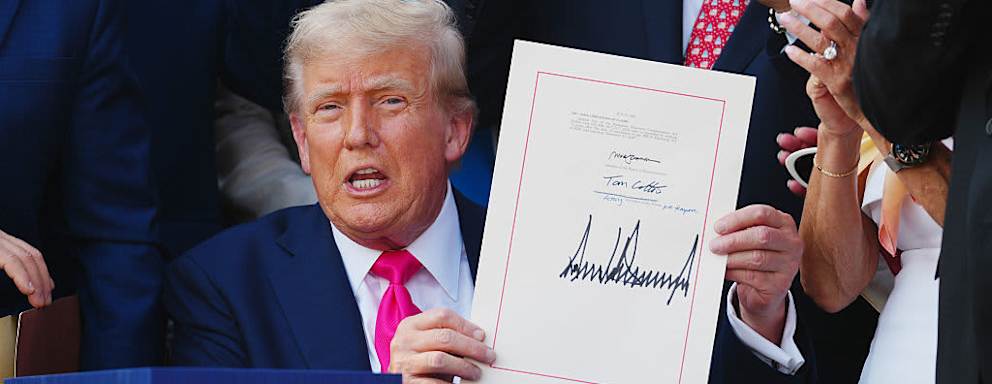One Big Beautiful Bill Has Huge Impacts on Higher Ed. Here’s Everything Students Need to Know
 Credit: Bloomberg / Getty Images
Credit: Bloomberg / Getty Images- President Trump signed his marquee domestic policy bill into law on July 4, 2025.
- Included in the law are caps on student borrowing and the elimination of the Grad PLUS loan program.
- The One Big Beautiful Bill also changes Pell Grant eligibility.
- It revokes some Biden-era regulations that affect students who were defrauded by their college or who attended colleges that closed while they were enrolled.
President Donald Trump’s domestic policy bill — dubbed the One Big Beautiful Bill — makes a litany of changes to the U.S. higher education system.
Perhaps most importantly for college students, it shakes up how people can expect to pay for college. From changes to Pell Grant eligibility to student loan caps, the ins and outs of the bill are worth examining to get a better understanding of whether it could affect your education goals.

Stay in the Know!
Subscribe to our weekly emails and get the latest college news and resources sent straight to your inbox!
Here’s what current and future college students should know about the One Big Beautiful Bill.
Changes to Federal Student Loans
The One Big Beautiful Bill makes a number of changes to the federal student loan system, largely based on proposals first seen in the College Cost Reduction Act.
Borrowing Limits
Beginning July 1, 2026, students will be limited in how much they can borrow to attend graduate or professional school each year. The Department of Education (ED) will also begin implementing lifetime borrowing limits on this date.
| Annual Limit | Aggregate Limit | |
|---|---|---|
| Graduate Students | $20,500 | $100,000 |
| Professional Students | $50,000 | $200,000, minus amount borrowed for graduate school |
| Parent PLUS | $20,000 per dependent student | $65,000 per dependent student |
The bill includes a $257,500 lifetime borrowing limit for all students.
The One Big Beautiful Bill includes a carveout for students who are already enrolled and have already received federal student loans prior to July 1, 2026. This essentially grandfathered in current students so that they don’t have to end their studies if they have already surpassed the lifetime loan limits.
Eliminating the Grad PLUS Loan Program
Federal Student Aid (FSA) will stop awarding Grad PLUS loans on July 1, 2026.
Historically, graduate and professional students have been able to access Grad PLUS loans to subsidize college expenses. There was no annual borrowing limit, allowing students to borrow up to the full cost of a graduate education.
Many Republicans and right-leaning think tanks have attributed the rising costs of graduate schools to the uncapped Grad PLUS program.
Other advocates worry that without Grad PLUS loans, students will be pushed toward riskier, private lending options.
Standard Repayment Plan Timeline Changes
Currently, all federal student loan borrowers are automatically enrolled in the standard repayment plan. This plan calculates fixed monthly payments so that borrowers will pay off their loans in 10 years.
A new standard repayment plan will set the timeline dependent on the balance of the loan.
| Amount Owed | Repayment Timeline |
|---|---|
| Less than $25,000 | 10 years |
| $25,000-$49,999 | 15 years |
| $50,000-$99,999 | 20 years |
| $100,000 or more | 25 years |
The new standard repayment plan applies only to loans made on or after July 1, 2026.
New Income-Driven Repayment Plan
The Repayment Assistance Plan (RAP) will become the only available income-driven repayment (IDR) plan moving forward. At one point, there were four IDR plans available to federal student loan borrowers.
Under RAP, most borrowers would pay a percentage of annual income, depending on their income level. All borrowers would have to make a minimum payment of at least $10 per month, whereas under previous IDR plans, some borrowers qualified for $0 monthly payments.
Monthly payments are lessened by $50 per dependent child listed on the borrower’s tax returns. The minimum $10 monthly payment, however, still applies.
| Adjusted Gross Income (AGI) | Base Payment |
|---|---|
| $10,000 or less | $120 per year |
| $10,001 – $20,000 | 1% of AGI |
| $20,001 – $30,000 | 2% of AGI |
| $30,001 – $40,000 | 3% of AGI |
| $40,001 – $50,000 | 4% of AGI |
| $50,001 – $60,000 | 5% of AGI |
| $60,001 – $70,000 | 6% of AGI |
| $70,001 – $80,000 | 7% of AGI |
| $80,001 – $90,000 | 8% of AGI |
| $90,001 – $100,000 | 9% of AGI |
| More than $100,000 | 10% of AGI |
RAP includes an interest subsidy. This means if a borrower’s monthly payment is not enough to cover the total interest cost for that month, ED will not charge the remaining interest that accrued for that month.
A borrower qualifies for complete loan forgiveness after making 360 qualifying payments under RAP — the equivalent of 30 years of continuous payments.
Parent PLUS borrowers cannot enroll in RAP.
Fewer Deferment, Forbearance Options
Loans made after July 1, 2027, will not be eligible for economic hardship deferment or unemployment deferment.
Deferment options allow borrowers to stop paying back their loans for a limited time. Under most deferment options, interest also stops accumulating on the borrower’s loan balance.
The Big Beautiful Bill also makes changes to forbearance options for federal student loan borrowers.
For loans made on or after July 1, 2027, borrowers may not spend more than nine months in forbearance during any 24-month period. Essentially, it limits how much time a borrower can utilize this option to delay or avoid loan payments.
New Accountability Rules
The One Big Beautiful Bill adds a major new accountability measure for colleges, while revoking a few longstanding rules.
New Earnings Threshold Introduced
College and university programs will now have to lead to minimum postgraduation earnings in order to disburse federal student loans to students.
In short, undergraduate programs must lead graduates to earnings better than the median pay of working adults with just a high school diploma. Graduate programs must lead to pay equal to the typical worker with a bachelor’s degree in the same field of study.
When comparing earnings for bachelor’s programs, ED will only look at working adults ages 25-34.
In most instances, wage data will focus on salaries from the state where the institution is located. However, if more than half of students enrolled reside outside the state, ED will use wage data from the entire U.S.
Delaying Existing Oversight Regulations
The One Big Beautiful Bill effectively erases changes made under former President Joe Biden’s administration to two oversight rules:
For all loans that originate before July 1, 2035, it will be as if the Biden-era regulatory changes never happened. Instead, ED will use the versions of borrower defense and closed school discharge that existed under Trump’s first administration.
Pell Grant Program Changes
The Pell Grant program is the federal government’s primary grant program to help low- and middle-income students afford college each year. Roughly 6 million students receive a Pell Grant each year.
Short-Term Pell Grant Expansion
Pell Grants can soon be applied toward workforce training programs as short as eight weeks.
Short-term Pell expansion — also referred to as workforce Pell — has long been a bipartisan policy issue. Until now, Pell Grants could only be applied to programs lasting at least 16 weeks.
Programs must meet the following requirements in order for students to qualify for a workforce Pell Grant:
- Between 150 and 600 clock hours of instruction
- Has been offered by the eligible institution for at least one year
- “Verified” completion rate of at least 70%, within 150% of the normal time to completion
- “Verified” job placement rate of at least 70%, measured 180 days after completion
- Tuition and fees not greater than the median earnings of completers or 150% of the federal poverty guidelines
State governors are also given leeway under the One Big Beautiful Bill to determine whether a program provides an education aligned with requirements of “high-skill, high-wage, or in-demand industry sectors or occupations.”
Limits to Pell Eligibility
The Big Beautiful Bill aims to eliminate Pell Grant eligibility for students with a high student aid index (SAI).
SAI is the calculation used to determine financial aid eligibility. Students with an SAI that equals or exceeds twice the amount of the total maximum Pell Grant would not qualify for the grant.
Beginning July 1, 2026, students will also no longer be eligible for a Pell Grant for any period in which the student receives grant aid from nonfederal sources that would already cover the student’s cost of attendance.
For example, if state grants and institutional scholarships would already fully cover a student’s cost of attendance, they won’t also get a Pell Grant in addition to their other aid.
Misc. Changes
The budget plan also made a few miscellaneous changes that college students ought to know about.
FAFSA Calculation Changes
The One Big Beautiful Bill adds a few exemptions for certain assets. This means students with the following assets could qualify for more financial aid, as the value of these assets won’t work against their SAI calculation.
Exemptions include:
- Family farm on which the family resides
- Small businesses with fewer than 100 full-time employees
- Commercial fishing business and related expenses, including fishing vessels
These exemptions will take effect starting with the 2026-27 academic year.
529 College Savings Plans
Students can now utilize college savings funds and 529 plans for a wider range of educational expenses.
Mainly, students can now apply 529 college savings plans to recognized postsecondary credential programs. This includes tuition, fees, books, and other supplies needed to attend these credential programs. It also applies to fees for testing or continuing education if such a test or continuing education is required to obtain or maintain a credential.
Programs must meet the following criteria to be a “recognized” postsecondary credential program:
- Included on a state list under the Workforce Innovation and Opportunity Act (WIOA)
- Listed in the public directory of the Web Enabled Approval Management System (WEAMS) of the Veterans Benefits Administration
- Require an exam to obtain or maintain such credential
- Identified by the secretary of education as being a reputable program